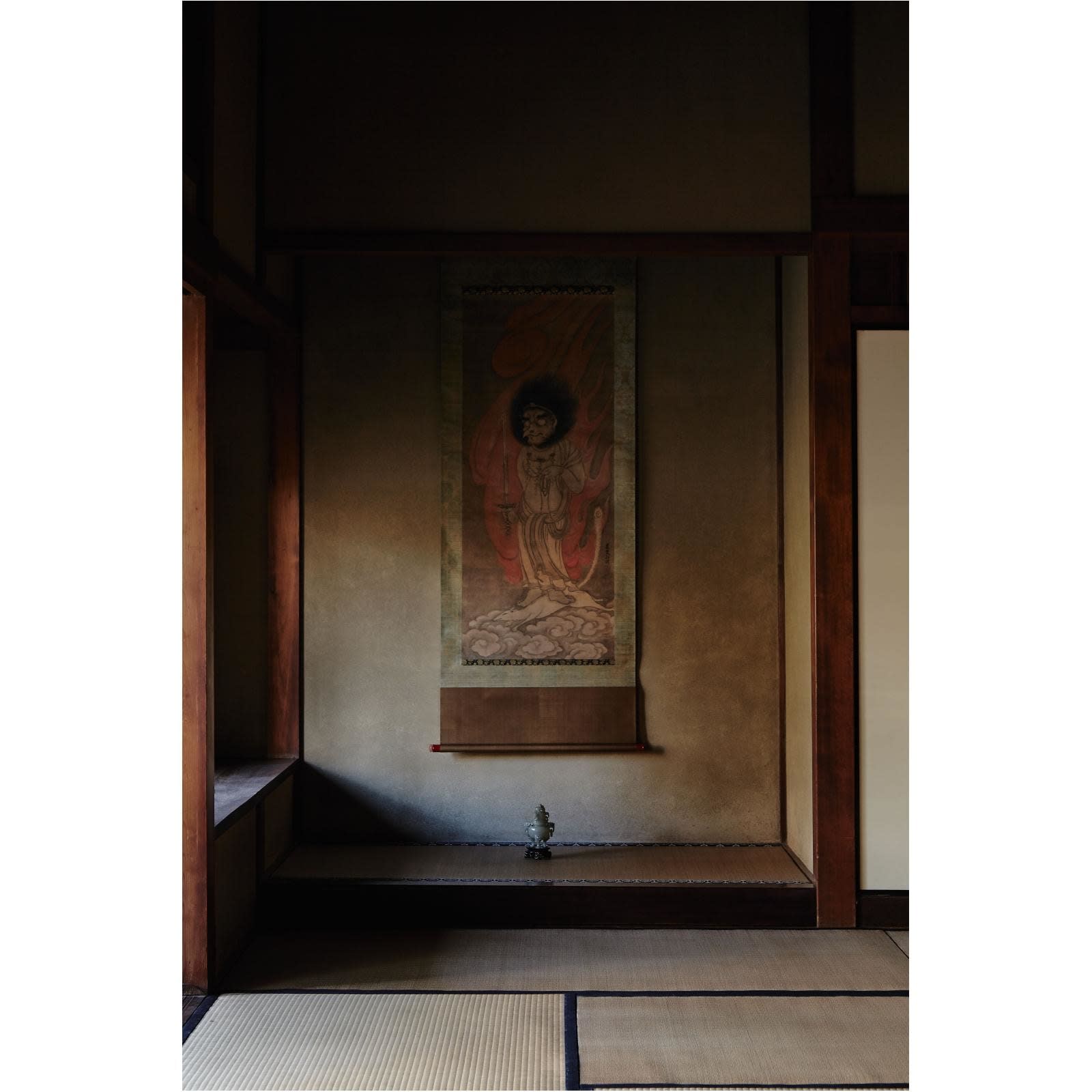Suiō Genro (1716–1789)
Akiba Daigongen (god of fire prevention)
Color on paper, hanging scroll
Seals: Genro; Futo Zuda
130 x 54.7 cm
222 x 70 cm (overall)
Seals: Genro; Futo Zuda
130 x 54.7 cm
222 x 70 cm (overall)
Further images
Suio Genro began training under the Zen master Hakuin Ekaku (1686–1768) in his thirties, and was known as one of Hakuin’s two foremost disciples along with Torei Enji. At Torei’s urging, Suio became the second abbot of Shoin-ji temple in Suruga Province after Hakuin’s death. Known as “the meticulous Torei and the daring Suio” in Zen style, the two figures were the opposite in their paintings. Compared to Torei’s characteristically bold, energetic works, Suio’s style conscientiously followed that of their teacher Hakuin. He was also known to have been friends with the painter Ike no Taiga.
Akiba Daigongen is a deity of Shinto and Buddhist syncretism associated with the mountain worship of Mount Akiba and shugendo practice and widely revered as a guardian against fires since ancient times. His appearance as a karasu tengu, or crow-billed goblin, comes from a legend of a priest who lived in Sanjaku-bo temple in Nagaoka, Echigo Province in the Muromachi period (1333–1573), gained the body of a mythical garuda bird, and flew around on a white fox, after seven days of austere practice. The priest came to be revered as the deity Akiba Sanjakubo Daigongen when he went to live on Mount Akiba in Totomi Province (now Shizuoka Prefecture). Today, he is enshrined in the Soto Zen temple Kasuisai in Shizuoka.
We know of three paintings of Akiba Daigongen by Suio’s teacher, Hakuin. Two of those appear to have been modeled after a Sanjakubo carving, purportedly made by Hakuin himself, at Shoin-ji temple. The other painting owned by Heirin-ji temple in Saitama Prefecture depicts a beaked figure with disheveled hair. The present painting closely follows this image by Hakuin, while emphasizing the strange quality of the deity. Perhaps Suio incorporated his “daring” personality into the painting here.
Suio Genro (Zen priest; 1716−1789)
Also known as Eboku.
Shimotsuke-born late Edo-period Rinzai School Zen priest. The second chief abbot of Shoin-ji temple in Suruga. Became a disciple of the Zen Master Hakuin Ekaku over thirty years old. Recognized as the two most prominent disciples of Hakuin, together with Torei Enji. Inherited the chief abbot post at Shoin-ji temple as advised by Torei. Took great pleasure in the Chinese literati leisure of composing poetry, drinking, go playing, and painting. Named himself “sui’o” meaning drunken old man at first, and changed to “sui’o” meaning accomplished man as advised by others. Acquainted with Ike no Taiga and others.
Akiba Daigongen is a deity of Shinto and Buddhist syncretism associated with the mountain worship of Mount Akiba and shugendo practice and widely revered as a guardian against fires since ancient times. His appearance as a karasu tengu, or crow-billed goblin, comes from a legend of a priest who lived in Sanjaku-bo temple in Nagaoka, Echigo Province in the Muromachi period (1333–1573), gained the body of a mythical garuda bird, and flew around on a white fox, after seven days of austere practice. The priest came to be revered as the deity Akiba Sanjakubo Daigongen when he went to live on Mount Akiba in Totomi Province (now Shizuoka Prefecture). Today, he is enshrined in the Soto Zen temple Kasuisai in Shizuoka.
We know of three paintings of Akiba Daigongen by Suio’s teacher, Hakuin. Two of those appear to have been modeled after a Sanjakubo carving, purportedly made by Hakuin himself, at Shoin-ji temple. The other painting owned by Heirin-ji temple in Saitama Prefecture depicts a beaked figure with disheveled hair. The present painting closely follows this image by Hakuin, while emphasizing the strange quality of the deity. Perhaps Suio incorporated his “daring” personality into the painting here.
Suio Genro (Zen priest; 1716−1789)
Also known as Eboku.
Shimotsuke-born late Edo-period Rinzai School Zen priest. The second chief abbot of Shoin-ji temple in Suruga. Became a disciple of the Zen Master Hakuin Ekaku over thirty years old. Recognized as the two most prominent disciples of Hakuin, together with Torei Enji. Inherited the chief abbot post at Shoin-ji temple as advised by Torei. Took great pleasure in the Chinese literati leisure of composing poetry, drinking, go playing, and painting. Named himself “sui’o” meaning drunken old man at first, and changed to “sui’o” meaning accomplished man as advised by others. Acquainted with Ike no Taiga and others.







